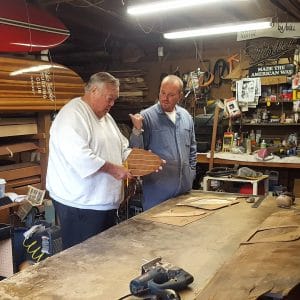Born in California, Noll’s mother moved them to Manhattan Beach when he was 6. By 10, he had started surfing, and learned “board shaping” — surfboard construction — from Dale Velzy, the world’s first commercial shaper, who had a shop in Manhattan Beach. At 17, Noll moved to O’ahu, Hawaii, to live and surf in Mākaha, thought by some to be the birthplace of surfing, and the site of the first international surfing competition in 1954. He made his living shaping boards. In 1956, as part of the United States Lifeguard Team, Noll went to the Summer Olympics in Melbourne, Australia, to demonstrate surf lifesaving techniques. The Aussies were stunned by their skills. “Took ’em from the horse and buggy straight to the Porsche,” he told Matt Warshaw, author of The History of Surfing (2010).

Noll was a big kid — 6-ft 2-in with a “bodybuilder” physique — which, along with his aggressive stance, earned him the nickname, “Da Bull”. He was known for his black-and-white-striped “jailhouse” swimming trunks so he could be easily identified by cameramen on the shore. He was also known to not be afraid of any wave. That was proven in November 1957, when he surfed 25-30 ft waves at Waimea Bay, which even native Hawaiians thought was impossible. In November 1964, he was the first to ride a wave breaking on the outside reef of the Banzai Pipeline, a reef break on O’ahu’s north shore. “The wave I caught at Outside Pipeline that day walled up 25-feet high about half a mile in front of me,” Noll wrote in his autobiography, Da Bull: Life Over the Edge. “It broke to the left, so I was riding with my back to the wave, goofyfoot, and it was a god-awful uneasy feeling. Instead of getting smaller as I rode it, the sonofabitch grew on me. It got bigger and bigger, and I started going faster and faster, until I was absolutely locked into it. I felt like I was on a spaceship racing into a void. At first, I could hear my board chattering across the face of the wave in a constant rhythm. As my speed increased, the chattering noise became less frequent. Suddenly there was no noise. For about fifteen or twenty feet, I was airborne. Then I literally was blown off my board.”

On December 4, 1969, Noll decided to tackle the waves at Mākaha, even though they were so big, he thought he only had a 50-50 chance of coming out alive. Noll paddled out toward a “huge, massive, black wall” of water, a witness said in the documentary, Riding Giants. “He stands up, and he’s this little speck on this gigantic wall, and you’re saying, ‘Oh, my God, he looks like this tiny cartoon figure.’ He gets into his stance — ‘Grrr, I’m going!’ — and he drops down, drops down, drops down, and he gets to the bottom of the wave, and it’s starting to come over the top of him, and he kind of steps off the rail. There was nowhere to go. That was it.” Noll barely survived the biggest wave ever surfed — “satellite images, along with atmosphere-gauging millibar charts and on-the-beach photographs, all prove that the swell was, in fact, the most powerful on record,” Warshaw wrote. He had to swim a mile against the rip tide to get back to shore. “If it had been anyone else in that situation,” said surfer Fred Hemmings, “he would have died.” The record stood for more than 20 years. A few days later, Noll dove into Waimea Bay — to save a floundering Navy seaman. “If he hadn’t brought him in, the guy would have drowned,” a witness told a local newspaper. After that, Noll moved to northern California, and worked as a commercial fisherman for the next 15 years. But he couldn’t stay away: as longboards made a comeback in the late 80s, Noll reopened his board shop and resumed shaping, continuing the craft into his 80s. He died June 28 in Crescent City, Calif., at 84.
